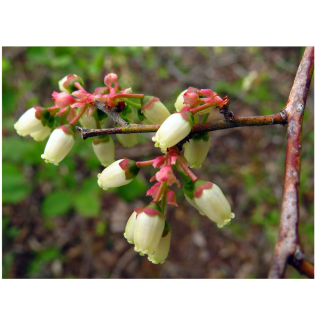
Habitat: forested wetlands, shrub swamps, bogs, upland woods; dry to wet woods, thickets, stream banks, rock outcroppings
Wildlife value: Flowers attract butterflies and bees. This plant provides nectar for pollinators and supports Brown Elfin larvae. Adult Brown Elfin butterflies feed on flower nectar. Its fruit attracts small mammals, ruffed grouse, wild turkey, black bears, squirrels, and songbirds, including American Robin, Eastern Bluebird, Scarlet Tanager, Eastern and Spotted Towhees, Gray Catbird, Northern Mockingbird, Brown Thrasher, and Northern Cardinal. The twigs provide food source for deer and rabbits. Members of the genus Vaccinium support bees
Notes: Blueberries prefer sandy or rocky material and require a lower soil pH than many other small-fruit crops and other plants. Therefore, consider grouping them with other acid-loving plants such as hollies, azaleas, rhododendrons, and camellias. Before planting, take a soil test. The ideal pH for highbush blueberry is 5.0. Little annual attention is required, except for occasional pruning. Prune out the oldest and weakest wood near the base of the plant (no more than a quarter of the plant) in late winter to encourage strong new growth, leaving growth that has the most of the fat fruiting buds, and remove any growth spreading out toward the ground. Plant two or more selections that bloom at the same time for best fruit production.
Carniola Farms Nursery
Nursery operates Arlington Native Plants & Edibles located at 925 N. Madison St. Arlington Virginia 22205. Plants can be purchased at any time by making an email appointment at carniolafarms@gmail.com. Also, during the during the planting season, they are open some Saturdays from 11AM to 3PM. Check their website for datesThis plant list is from the beginning of the 2025 season and may be out-of-date
| In Stock? | Notes | ||
|---|---|---|---|
| Yes | View My Wishlist |
Bona Terra Nursery
Small family-run native plant nursery with a focus on the local genetics necessary to restore diversity in the Chesapeake eco-region. Offers free remote design service for small gardens up to 400 square feet. Orders are placed via email and items can be picked up at their NW DC office or delivered for a fee. This plant list is from the beginning of the 2025 season and may be out-of-date
| Pots Available | Pot Size | Notes | Add to Wishlist | |
|---|---|---|---|---|
| 0 | 1 Gallon |
203 One gallon available Sept 2025 |
View My Wishlist | |
| 0 | 3 Gallon |
203 One gallon available Sept 2025 |
View My Wishlist | |
| 0 | 1 Gallon |
120 One gallon available Sept 2025 |
View My Wishlist | |
| 0 | 3 Gallon |
120 One gallon available Sept 2025 |
View My Wishlist | |
| 0 | 1 Gallon |
108 One gallon available Sept 2025 |
View My Wishlist | |
| 0 | 3 Gallon |
108 One gallon available Sept 2025 |
View My Wishlist | |
| 1 | 3 Gallon |
Local Ecotype coming soon! |
View My Wishlist |


